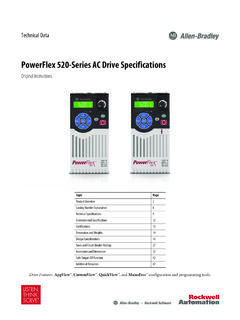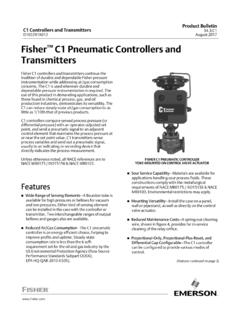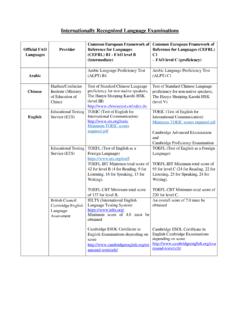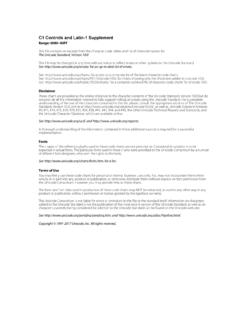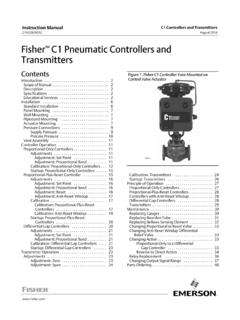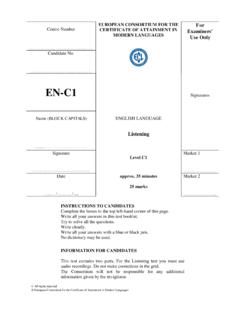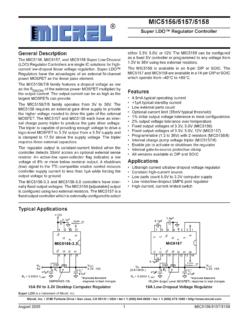Transcription of Multiplying DACs Flexible Building Blocks - Analog …
1 Multiplying DACs Flexible Building Blocks Analog Devices has a comprehensive family of 8-/10-/12-/14-/16-bit Multiplying digital-to- Analog converters. As a result of manufacture on a CMOS. submicron process, these DACs offer excellent 4-quadrant multiplication characteristics. By offering flexibility and simplicity, Multiplying DAC products are an ideal Building block in a broad range of both fixed and varying input reference applications. These parts can handle up to 18 V inputs on the reference, despite operating from a single-supply power supply of up to V to V. An integrated feedback resistor (RFB) provides temperature tracking and full-scale voltage output when combined with an external current-to-voltage precision amplifier. Analog Devices has now revamped its portfolio of high resolution 14-/16-bit current output products to include: Improved linearity of 1 LSB INL. HIGH ACCURACY. Improved Analog THD, Multiplying feedthrough, and higher Multiplying bandwidth 16-BIT, 1 LSB INL.
2 Performance for varying reference voltage multiplication Improved digital THD, midscale glitch, and digital feedthrough for fixed reference WIDE INPUT LOW OUTPUT GLITCH. REFERENCE RANGE. voltage multiplication 18V. IMPULSE 1nV/s With the launch of the improved AD55xx products, ADI has added to the already high DIGITAL VREF. performance 8-/10-/12-bit AD54xx family of current output DACs. These updated INPUT Multiplying . CODE DACS. current output DAC products enable Analog designers to address an even wider range of both fixed and varying reference Multiplying applications. FAST SETTLING. 12 MHz MBW TIME s 8-BIT TO 16-BIT. RESOLUTION. Multiplying DACs By offering both flexibility and simplicity, Multiplying DACs can be used in a broad range of applications. The benefit of a discrete DAC and op amp solution is that the op amp selection can be custom tailored to suit the application requirements. Multiplying DACs are ideal Building Blocks for fixed reference applications, where the user wants to generate a waveform from a fixed dc voltage.
3 They are also ideally suited for varying reference applications, where the user wants to digitally condition an ac or arbitrary reference voltage. The AD54xx and revamped AD55xx families of Multiplying DACs have been designed to target both these application spaces. Multiplying DACs have a number of extra features to assist designers in generating the desired output signal. Some Multiplying DACs, such as the AD5405 and AD5545, include uncommitted matched resistors, whereby a positive output can be obtained simply by connecting an additional op amp (A2 in Figure 2), which could be the companion op amp within a dual device. Some generics of the family, including the AD5546 and AD5544, have the added feature of resetting to midscale or zero scale, which is useful in bipolar applications. The required op amp to support these applications can be selected for particular specifications, for example, high gain bandwidth, high slew rate, low noise, etc.
4 Key Advantages of AD55xx DACs for Multiplying AC/Arbitrary Reference Applications High Multiplying bandwidth signals can be multiplied up to this frequency before they are attenuated by more than 3 dB. The AD5544/AD5554 can multiply signals up to 12 MHz. See Figure 1. Low Multiplying feedthrough this is the error due to capacitive feedthrough from the reference input to the DAC output, when all 0's are loaded to the DAC. This measures the amount of possible distortion in the multiplied signal the AD5544 measures as low as 65 dB at 100 kHz. Excellent Analog THD a mathematical representation of the harmonic content in the multiplied waveform signal. It is the rms sum of the harmonics (V2, V3, V4, and V5) of the DAC output to the fundamental value, V1, given by Equation 1. Measures as low as 103 dB on the AD5543. V2 2 + V3 2 + V4 2 + V5 2. THD = 20 log (1). V1. AC REFERENCE. VDD RFB C1. IOUT1. 0V VREF AD55xx A1 0V.
5 AGND. SYNC SCLK SDIN. AGND ATTENUATED REFERENCE. MICROCONTROLLER. C0 1 WHERE: CO = OUTPUT IMPEDANCE OF DAC. C1 = 2 . 2 RFB GBW GBW = GAIN BANDWIDTH PRODUCT OF OP AMP. Figure 1. Multiplying DAC varying reference positive reference in/negative out configuration. Circuit Note CN-0025, Precision, AC Reference Signal AN-1094 Application Note, Multiplying DACs Attenuator Using the AD5546/AD5556 Multiplying DAC. Fixed Reference, Waveform Generation Applications. A2. C2. RCOM VREF ROFS RFB. AC REFERENCE C1. ATTENUATED REFERENCE. R1. IOUT1. VDD AD55xx A1. 0V AGND 0V. SYNC SCLK SDIN AGND. MICROCONTROLLER. Figure 2. Multiplying DAC varying*UNCOMMITTED. reference positive reference RESISTOR in/positive VERSIONS out configuration. ONLY. 2 | Multiplying DACs Key Advantages of AD55xx DACs for Multiplying DC Reference Applications Fast settling time the AD55xx benefit from a s settling time from zero scale to full scale within The AD54xx have zero scale to full scale settling time of sub s to within High slew rate due to fast switching architecture of the AD54xx and AD55xx families, an operational amplifier with a slew rate of >100 V/ s is sufficient to not limit the DAC performance.
6 Low glitch low in R2R structures due to the fact that the current is steered either to ground or virtual ground. The worst case is the midscale glitch, which can measure as low as 1 nV/s for the AD55xx parts. Low noise the AD54xx and AD55xx family of IOUT DACs utilize low impedance architectures. These are inherently low noise architectures dominated by the thermal noise of the RDAC resistor. VDD RFB C1 GENERATED. +VE VREF WAVEFORM. IOUT1. VREF AD55xx A1. 0V AGND 0V. SYNC SCLK SDIN. AGND. MICROCONTROLLER. Figure 3. Multiplying DAC fixed reference unipolar operation. AN-1085 Application Note, Multiplying DACs AC/Arbitrary Reference Applications. R3. 10k . R2 R5. 10k . VDD RFB C1 GENERATED. +VE VREF R4 WAVEFORM. IOUT1 5k . VREF AD55xx A1. R1 AGND A2. 0V 0V. SYNC SCLK SDIN. AGND. MICROCONTROLLER. NOTES. 1. R1 AND R2 ARE USED ONLY IF GAIN ADJUSTMENT IS REQUIRED. ADJUST R1 FOR VOUT = 0V WITH CODE 10000000 LOADED TO DAC.
7 2. MATCHING AND TRACKING ARE ESSENTIAL FOR RESISTOR PAIRS. R3 AND R4. Figure 4. Multiplying DAC fixed reference bipolar operation. Circuit Note CN-0028, Precision, Bipolar Configuration for the AD5547/AD5557 DAC. | 3. IOUT Family Tree AD5543/AD5544/AD5545/. AD5546/AD5547. 16-BIT, 1 LSB, SINGLE-/DUAL-/QUAD-CHANNEL. SPI/PARALLEL. >10 MHz Multiplying BANDWIDTH. AD5553/AD5554/. AD5555/AD5556/AD5557/. AD5453/AD5446 14-BIT, 1 LSB, SINGLE-/DUAL-/QUAD-CHANNEL. SPI/PARALLEL. RESOLUTION. >10 MHz Multiplying BANDWIDTH. AD5415/. AD5441/AD5443/AD5444/. AD5445/AD5447/AD5449/. AD5452/AD5405 12-BIT, SINGLE-/DUAL-CHANNEL. SPI/PARALLEL. >10 MHz Multiplying BANDWIDTH. LFCSP/MSOP/TSSOP. AD5450/AD5451/. AD5424/AD5425/AD5426/. AD5428/AD5429/. AD5433/AD5440 8-/10-BIT, SINGLE-/DUAL-CHANNEL. SPI/PARALLEL. >10 MHz Multiplying BANDWIDTH. MSOP/TSSOP. AD54xx AD55xx AD5543 Specifications AD5544 Specifications Single channel Quad channel 16-bit resolution 16-bit resolution 1 LSB DNL 1 LSB DNL.
8 1 LSB INL 1 LSB INL. Low noise: 12 nV/ Hz 2 mA full-scale current 20%, with VREF = 10 V. Low power: IDD = 10 A s settling time to s settling time 12 MHz Multiplying bandwidth 7 MHz Multiplying bandwidth Midscale glitch of 1 nV/sec Analog THD of 103 dB Midscale or zero-scale reset 2 mA full-scale current 20%, with VREF = 10 V Four separate, 4-quadrant Multiplying reference inputs Built-in RFB facilitates voltage conversion SPI-compatible, 3-wire interface SPI-compatible, 3-wire interface Simultaneous multichannel change Temperature range: 40 C to +125 C Temperature range: 40 C to +125 C. Ultracompact 8-lead MSOP and 8-lead SOIC packages Compact 28-lead SSOP; 5 mm 5 mm, 32-lead LFCSP. 4 | Multiplying DACs Applications Low Noise LED Control ADC MICROCONTROLLER DAC CONTROL. A. C1 RFB VDD. IOUT1 PHOTODIODE +. A1 AD55xx VREF I/V AMP. AGND LPF. AGND. Fast Settling Ramp Control on Motors VDD RFB C1. IOUT1. VREF AD55xx A1 MOTOR CONTROL.
9 AGND. SYNC SCLK SDIN. AGND. MASS. SPECTROMETER. MICROCONTROLLER. DETECTOR + SIGNAL. ADC 1. CONDITIONING. CH1 200mV M400ns A CH1 412mV. Circuits from the Lab by Analog Devices is a new design assistance resource that provides engineers with tested circuit solutions for many common applications. Circuits from the Lab pairs at least two complementary components, such as an ADC and amplifier, to present a circuit optimized for a targeted application. Each circuit has been built and tested in the lab and can be easily integrated into designs, resulting in reduced design risk and faster time to market. Circuit note documentation accompanies each Circuits from the Lab design and describes the circuit function, benefits, and implementation in detail, with common variations noted. View the collection of circuit notes available for Multiplying DAC designs at | 5. Applications Single-Ended-to-Differential Conditioning A2.
10 C2. RCOM VREF ROFS RFB A3 AC REFERENCE C1. R1 DIFFERENTIAL. IOUT1 OUTPUT VOLTAGE. VDD AD55xx A1. AGND. SYNC SCLK SDIN AGND A4 MICROCONTROLLER. *UNCOMMITTED RESISTOR VERSION. Circuit Note CN-0143, Single-Ended-to-Differential Converters for Voltage Output and Current Output DACs Using the AD8042 Op Amp. Fast Settling Ramp Generation and Offset Control RFBA. AD5545 GENERATED WAVEFORM. 16-BIT C1. OFFSET. ADR423. VREFA DAC IOUTA A1 0V. VDD. VOUT VREFB. AD5621 AWG IOUTB. AGND. 12-BIT DAC. For more information on ADI's Multiplying DAC portfolio see 6 | Multiplying DACs Multiplying DACs Part Number Bits Outputs Interface Package Comments AD5424 8 1 Parallel 16-lead TSSOP, 20-lead LFCSP >10 MHz BW, 10 V signals AD5426 8 1 SPI 10-lead MSOP >10 MHz BW, 10 V signals; see also AD5425 fast load Small SOT-23 package; see also AD5425 fast load; pin- and software- AD5450 8 1 SPI 8-lead SOT-23. compatible family 12 MHz update rate AD5425 8 1 SPI, 8-bit load 10-lead MSOP >10 MHz BW, 10 V signals; see also AD5426.










